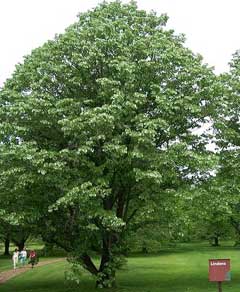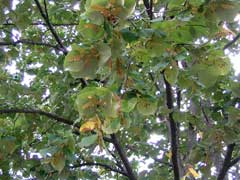 |
|
http://commons.wikimedia.org/wiki/User:Bruce_Marlin |
 |
| fr.wikipedia.org/wiki/Utilisateur:Jeantosti |
Translate this page:
Summary
Bloom Color: Yellow. Main Bloom Time: Early summer, Late summer, Mid summer. Form: Oval, Pyramidal, Rounded.
Physical Characteristics

 Tilia tomentosa is a deciduous Tree growing to 25 m (82ft) by 20 m (65ft) at a medium rate.
Tilia tomentosa is a deciduous Tree growing to 25 m (82ft) by 20 m (65ft) at a medium rate.
See above for USDA hardiness. It is hardy to UK zone 6 and is not frost tender. It is in flower from July to August. The species is hermaphrodite (has both male and female organs) and is pollinated by Insects.
Suitable for: light (sandy), medium (loamy) and heavy (clay) soils and prefers well-drained soil. Suitable pH: mildly acid, neutral and basic (mildly alkaline) soils. It can grow in semi-shade (light woodland) or no shade. It prefers dry or moist soil.
UK Hardiness Map
US Hardiness Map
Synonyms
T. alba. T. argentea. DC.
Plant Habitats
Woodland Garden Canopy;
Edible Uses
Edible Parts: Leaves
Edible Uses: Condiment Tea
Young leaves - raw or cooked[179]. The dried leaves are sometimes used as an adulterant for marjoram (Origanum majorana)[183]. A tea can be made from the flowers. A very good chocolate substitute is made from a paste of the ground fruits and flowers[2]. Trials on marketing the product failed because the paste decomposes readily[2].
References More on Edible Uses
Medicinal Uses
Plants For A Future can not take any responsibility for any adverse effects from the use of plants. Always seek advice from a professional before using a plant medicinally.
Antispasmodic Diaphoretic Sedative
A tea made from the flowers is antispasmodic, diaphoretic and sedative[226].
References More on Medicinal Uses
The Bookshop: Edible Plant Books
Our Latest books on Perennial Plants For Food Forests and Permaculture Gardens in paperback or digital formats.

Edible Tropical Plants
Food Forest Plants for Hotter Conditions: 250+ Plants For Tropical Food Forests & Permaculture Gardens.
More

Edible Temperate Plants
Plants for Your Food Forest: 500 Plants for Temperate Food Forests & Permaculture Gardens.
More

More Books
PFAF have eight books available in paperback and digital formats. Browse the shop for more information.
Shop Now
Other Uses
Fibre
A fibre is obtained from the tough inner bark It can be made into diverse items such as mats, shoes and coarse cloth[229].
Special Uses
Food Forest Scented Plants
References More on Other Uses
Cultivation details
Landscape Uses:Firewood, Pollard, Screen, Specimen, Street tree. Prefers a good moist loamy alkaline to neutral soil but succeeds on slightly acid soils[11, 200]. Grows poorly on any very dry or very wet soil[200]. According to another report this species succeeds in a hot dry position. Dislikes exposed positions[200]. Succeeds in sun or semi-shade[188]. This species thrives in southern England[11], though it prefers a continental climate, growing more slowly and not producing fertile seed in areas with cool summers[200]. Lime trees tend to hybridise freely if other members of the genus are growing nearby[238]. If growing plants from seed it is important to ensure the seed came from a wild source or from an isolated clump of the single species[K]. Grows best in a woodland situation, young plants tolerate a reasonable level of side shade[200]. The fragrant flowers of this tree are toxic to bees[188]. Trees are usually attacked by aphids which cover the ground and the leaves with a sticky honeydew[188]. Rarely produces suckers. Quite tolerant of root disturbance, semi-mature trees up to 5 metres tall have been transplanted successfully. Plants in this genus are notably resistant to honey fungus[200]. Special Features:Attracts birds, Attractive foliage, Not North American native, Fragrant flowers, Attractive flowers or blooms.
References Carbon Farming Information and Carbon Sequestration Information
Temperature Converter
Type a value in the Celsius field to convert the value to Fahrenheit:
Fahrenheit:
The PFAF Bookshop
Plants For A Future have a number of books available in paperback and digital form. Book titles include Edible Plants, Edible Perennials, Edible Trees,Edible Shrubs, Woodland Gardening, and Temperate Food Forest Plants. Our new book is Food Forest Plants For Hotter Conditions (Tropical and Sub-Tropical).
Shop Now
Plant Propagation
Seed - much of the seed produced in Britain is not viable, cut a few seedcases open to see if there is a seed inside[80]. If possible, obtain fresh seed that is ripe but has not as yet developed a hard seed coat and sow it immediately in a cold frame. It may germinate in the following spring though it could take 18 months[80]. Stored seed can be very slow to germinate. It has a hard seed coat, embryo dormancy and a hard coat on the pericarp. All these factors mean that the seed may take up to 8 years to germinate[80]. One way of shortening this time is to stratify the seed for 5 months at high temperatures (10°c at night, up to 30°c by day) and then 5 months cold stratification[80]. When they are large enough to handle, prick the seedlings out into individual pots and grow them on in the greenhouse for their first winter. Plant them out into their permanent positions in late spring or early summer, after the last expected frosts. Layering in spring just before the leaves unfurl. Takes 1 - 3 years[78]. Suckers, when formed, can be removed with as much root as possible during the dormant season and replanted immediately[200].
Other Names
If available other names are mentioned here
Native Range
TEMPERATE ASIA: Turkey (west) EUROPE: Hungary, Moldova, Ukraine (southwest), Former Yugoslavia, Albania, Bulgaria, Greece, Romania
Weed Potential
Right plant wrong place. We are currently updating this section.
Please note that a plant may be invasive in one area but may not in your area so it's worth checking.
Conservation Status
IUCN Red List of Threatened Plants Status :

| Related Plants
|
| Latin Name | Common Name | Habit | Height | Hardiness | Growth | Soil | Shade | Moisture | Edible | Medicinal | Other |
| Corchorus capsularis | Jute | Annual/Perennial | 3.5 |
9-11
| F | LMH | N | M | 3 | 2 | 2 |
| Corchorus olitorius | Jew's Mallow, Nalta jute | Annual/Perennial | 3.5 |
9-11
| F | LMH | N | M | 4 | 2 | 4 |
| Entelea arborescens | Corkwood Tree | Shrub | 6.0 |
8-11
| | LMH | N | M | 0 | 0 | 2 |
| Grewia biloba parviflora | | Shrub | 3.0 |
5-9
| | LMH | SN | M | 1 | 0 | |
| Grewia oppositifolia | | Shrub | 0.0 |
8-11
| | LMH | SN | M | 2 | 0 | 2 |
| Talipariti tiliaceum | Beach Hibiscus, Sea Hibiscus, Cottontree, Mahoe | Tree | 10.0 |
10-12
| F | LMH | N | MWe | 3 | 2 | 4 |
| Tilia americana | American Basswood, Carolina basswood, Basswood, AmericanBasswood, American Linden | Tree | 25.0 |
3-9
| M | LMH | SN | M | 3 | 3 | 3 |
| Tilia amurensis | | Tree | 30.0 |
4-8
| M | LMH | SN | M | 3 | 1 | 1 |
| Tilia caroliniana | Carolina Basswood | Tree | 20.0 |
6-9
| M | LMH | SN | M | 3 | 1 | 2 |
| Tilia chinensis | | Tree | 25.0 |
4-8
| M | LMH | SN | M | 3 | 1 | 1 |
| Tilia cordata | Small Leaved Lime, Littleleaf linden | Tree | 30.0 |
3-7
| M | LMH | SN | M | 5 | 3 | 3 |
| Tilia heterophylla | White Basswood, American basswood | Tree | 30.0 |
4-8
| M | LMH | SN | M | 3 | 2 | 3 |
| Tilia japonica | Japanese Lime | Tree | 20.0 |
5-9
| M | LMH | SN | M | 3 | 1 | 2 |
| Tilia mongolica | Mongolian Lime | Tree | 15.0 |
3-6
| M | LMH | SN | M | 3 | 1 | 1 |
| Tilia oliveri | | Tree | 15.0 |
5-9
| M | LMH | SN | M | 3 | 1 | 1 |
| Tilia platyphyllos | Large Leaved Lime, Largeleaf linden, Bigleaf Linden | Tree | 30.0 |
4-6
| M | LMH | SN | M | 5 | 3 | 4 |
| Tilia tuan | | Tree | 16.0 |
5-9
| M | LMH | SN | M | 3 | 1 | 2 |
| Tilia x europaea | Linden, Common Lime | Tree | 35.0 |
3-9
| M | LMH | SN | M | 5 | 3 | 3 |
|
Growth: S = slow M = medium F = fast. Soil: L = light (sandy) M = medium H = heavy (clay). pH: A = acid N = neutral B = basic (alkaline). Shade: F = full shade S = semi-shade N = no shade. Moisture: D = dry M = Moist We = wet Wa = water.
Now available:
Food Forest Plants for Mediterranean Conditions
350+ Perennial Plants For Mediterranean and Drier Food Forests and Permaculture Gardens.
[Paperback and eBook]
This is the third in Plants For A Future's series of plant guides for food forests tailored to
specific climate zones. Following volumes on temperate and tropical ecosystems, this book focuses
on species suited to Mediterranean conditions—regions with hot, dry summers and cool, wet winters,
often facing the added challenge of climate change.
Read More
Expert comment
Author
Moench.
Botanical References
1174200
Links / References
For a list of references used on this page please go here
Readers comment